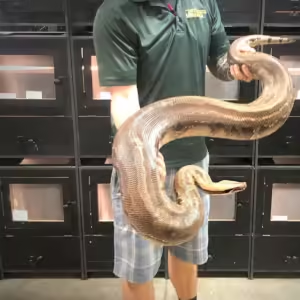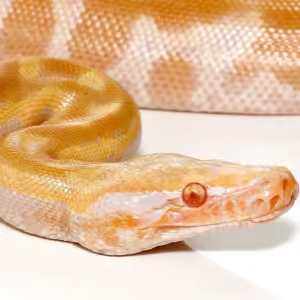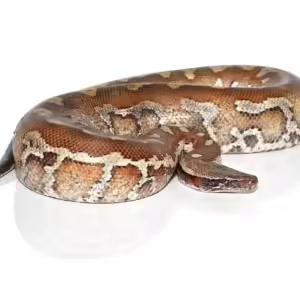Black Blood Python For Sale
$249.99
WE HAVE BLACK BLOOD PYTHON FOR SALE. HERE ARE SOME HIGHLIGHTS:
- Python curtus
- Captive Bred
- Approximately 27 – 28 Inches In Length
- Adults Can Grow Up To 4 – 5 Feet In Length
- Feeding On Live And Frozen/Thawed Rat Pups
FUN FACTS!
- Blood Pythons Are Terrestrial Snakes Living Their Lives On The Forest Floor Blending In With The Leaf Litter And Attacking Prey By Surprise
- This Species Can Be Feisty But With Regular Handling Tames Down Well
- These Originate From SW Thailand, Eastern Sumatra (Indonesia) and the Malay Peninsula
- With Proper Care These Snakes Can Live Up To 20-25 Years At A Time
Black Blood Python
The Black Blood Python, scientifically known as Python curtus, is a captivating species that has intrigued herpetologists and reptile enthusiasts alike. Native to the lush and diverse ecosystems of Southeast Asia, this python species can be found in countries such as Indonesia, Malaysia, and Thailand. Its distinct characteristics and unique adaptations make it a subject of interest for those studying reptilian biodiversity and behavior.
One of the most striking features of the Black Blood Python is its robust and muscular body, typically reaching lengths of three to six feet. Unlike other python species that are known for their slender and elongated physiques, the Black Blood Python is characterized by its short and stout form, which contributes to its powerful constriction abilities. The coloration of this python varies, but it often displays a dark, almost black, base color with intricate patterns of gold, brown, and cream, offering a stunning visual appeal.
In its natural habitat, the Black Blood Python thrives in tropical rainforests, swamps, and marshy areas where humidity levels are high. This environment provides ample opportunities for the python to hunt and camouflage itself from predators. The Black Blood Python primarily preys on small mammals and birds, using its acute sense of smell and heat-sensing pits to locate and ambush its prey effectively.
Understanding the habitat and physical characteristics of the Black Blood Python is essential for appreciating its ecological role and conservation status. As with many wildlife species, habitat destruction and human activities pose significant threats to its population. Consequently, efforts to conserve its natural habitat and ensure sustainable practices are crucial for maintaining the delicate balance of these ecosystems.
Physical Characteristics
The Black Blood Python, scientifically known as Python brongersmai, boasts a set of distinctive physical features that set it apart from other python species. A key highlight is its striking coloration. The scales of the Black Blood Python typically exhibit a rich, dark hue, ranging from deep black to dark brown, often interspersed with intricate patterns of lighter shades. This distinctive coloration serves not only as a means of camouflage within their natural habitat but also contributes to their allure among reptile enthusiasts.
In terms of size, the Black Blood Python is relatively robust. Adult specimens can reach lengths of up to 6 feet, although individuals exceeding this length are not uncommon. Their weight, often ranging between 10 to 15 pounds, underscores their muscular build. Unlike more slender python species, the Black Blood Python has a stocky and heavily built body, which is densely packed with muscle. This robust physique is an adaptation that aids in constricting prey effectively, a hallmark of their hunting strategy.
Sexual dimorphism is present in this species, with females typically larger and more robust than males. This size difference is attributed to reproductive roles, as females need additional mass to support egg development. Males, while smaller, are often more agile, a trait that may aid in locating females during the breeding season.
One of the fascinating aspects of this python is the origin of its common name, ‘blood python.’ This name is derived not from any sanguineous behavior but from the blood-red coloration found in some individuals, particularly those from certain localities. This vivid red hue adds to the mystique and appeal of the species.
When comparing the Black Blood Python to other python species, their stout form and remarkable coloration stand out. While many pythons, such as the Ball Python or the Reticulated Python, exhibit diverse patterns and colors, the Black Blood Python’s unique blend of dark, rich shades and powerful build offers a distinct silhouette and presence in the world of reptiles.
Natural Habitat and Distribution
The Black Blood Python, scientifically known as Python brongersmai, primarily inhabits the lush and humid environments of Southeast Asia. This region’s diverse ecosystems, ranging from dense tropical rainforests to expansive swamps and marshes, provide the ideal conditions for the species to thrive. Within these ecosystems, the Black Blood Python often favors areas with abundant vegetation and water sources, which support their predatory lifestyle and offer ample hiding spots from potential threats.
In terms of geographical distribution, the Black Blood Python is predominantly found in countries such as Thailand, Malaysia, and Indonesia. These nations boast a rich array of habitats that cater to the needs of this python, enabling it to sustain healthy populations. For instance, in Malaysia, the species is commonly observed in the lowland rainforests, which are characterized by high humidity, dense foliage, and a wealth of prey species. Similarly, in the peat swamps and marshlands of Indonesia, the Black Blood Python exploits the waterlogged terrain to hunt and seek refuge.
One of the most remarkable aspects of the Black Blood Python is its adaptability to different habitats within its range. While they exhibit a preference for moist, tropical environments, these resilient reptiles can also be found in secondary forests and agricultural areas, demonstrating their ability to survive in altered landscapes. This adaptability is crucial for their survival, particularly in regions facing significant habitat modification due to human activities.
Overall, the Black Blood Python’s natural habitat and distribution highlight the species’ reliance on Southeast Asia’s unique ecosystems. Their presence in various countries and diverse environments within this region underscores their ecological importance and the need for conservation efforts to preserve their habitats amidst growing environmental pressures.
Diet and Hunting Behavior
The Black Blood Python, a captivating reptile native to Southeast Asia, exhibits intriguing dietary patterns and hunting behaviors that distinguish it within its ecosystem. As a carnivorous predator, the Black Blood Python primarily preys on small mammals, birds, and occasionally other reptiles. This dietary preference positions the Black Blood Python as a crucial regulator of the populations of these species, maintaining ecological balance.
One of the most striking aspects of the Black Blood Python’s hunting strategy is its use of ambush tactics. Unlike active hunters that pursue their prey, the Black Blood Python relies on stealth and patience. It typically remains motionless, blending seamlessly into its surroundings thanks to its dark, earthy coloration. When an unsuspecting prey animal comes within striking distance, the python launches a rapid and precise attack, utilizing its powerful constricting ability to subdue the prey.
Black Blood Pythons possess specialized sensory adaptations that enhance their hunting efficiency. Among the most notable are their heat-sensing pits located along their upper lip. These pits allow the python to detect the infrared radiation emitted by warm-blooded prey, enabling it to hunt effectively even in low-light conditions. This adaptation is particularly advantageous in the dense forests and swamps where visibility is often limited.
Once the prey is captured, the Black Blood Python employs its strong, muscular body to constrict and suffocate the animal, ensuring a swift kill. Following this, the python consumes its prey whole, thanks to its highly flexible jaws and expandable stomach. This method of ingestion allows the python to tackle prey much larger than its head, ensuring ample nourishment from each successful hunt.
As predators, Black Blood Pythons play a vital role in their habitats. By controlling the populations of small mammals and birds, they help maintain a balanced ecosystem. Their presence also indicates a healthy, functioning environment, as top predators are often keystone species whose well-being reflects the overall health of the ecosystem.
Reproduction and Lifespan
The Black Blood Python, a species known for its enigmatic and captivating presence, exhibits intriguing reproductive behaviors. Mating season for these pythons generally occurs from November to January, a period marked by distinct courtship rituals. Male Black Blood Pythons engage in combat dances, where they entwine and wrestle to showcase their dominance and attract females. Once a pair has successfully mated, the female will typically lay a clutch of 12-16 eggs after an incubation period that spans roughly 60 to 70 days.
Egg-laying practices of the Black Blood Python are meticulous. Females are known to select secure and humid environments to deposit their eggs, ensuring optimal conditions for development. They exhibit maternal instincts by coiling around their eggs to regulate temperature and humidity levels, which are crucial for the successful hatching of offspring. The young emerge from the eggs equipped with the necessary skills for survival, although their initial period is fraught with vulnerability.
In terms of lifespan, Black Blood Pythons in the wild can live up to 20 years, although their life expectancy is often curtailed by environmental factors, predation, and human activities. In captivity, however, these pythons can live significantly longer, often exceeding 25 years due to the controlled environment, regular feeding, and absence of natural predators. Factors that contribute to their longevity in captivity include proper husbandry practices, a balanced diet, and regular veterinary care.
Understanding the reproductive cycle and lifespan of the Black Blood Python is essential for conservation efforts and captive breeding programs. These insights not only enhance our appreciation of this remarkable species but also inform strategies to ensure their continued survival both in the wild and in captivity.
Behavior and Temperament
The Black Blood Python exhibits distinctive behavior and temperament, both in the wild and in captivity. In their natural habitat, these pythons are generally solitary and exhibit crepuscular activity, meaning they are most active during dusk and dawn. Their primary behavior involves burrowing into the forest floor or hiding under dense foliage to avoid predators and to ambush prey. Their diet mainly consists of small mammals and birds, and their hunting strategy relies heavily on their ability to remain motionless and strike swiftly when an opportunity presents itself.
Interactions with other animals are typically limited to predation or defensive encounters. When threatened, the Black Blood Python may exhibit defensive behavior such as hissing, puffing up their body to appear larger, or making rapid, defensive strikes. However, they rarely engage in pursuit and prefer to retreat if an escape route is available. In captivity, their behavior can vary significantly based on the individual snake and the conditions in which they are kept.
Among snake enthusiasts, the Black Blood Python has a mixed reputation. Some appreciate their striking appearance and relatively manageable size, while others caution against their sometimes unpredictable nature. Captive-bred individuals tend to be more docile compared to their wild-caught counterparts. Proper handling and consistent, gentle interaction can result in a more tolerant and calm demeanor over time.
It is important to note that the temperament of the Black Blood Python can differ widely between individuals. Factors such as genetics, handling frequency, and environmental conditions all play a role in shaping their behavior. For snake keepers, understanding these factors and providing an appropriate habitat can significantly enhance their experience with these fascinating reptiles.
Conservation Status and Threats
The Black Blood Python (Python brongersmai) is a captivating species native to Southeast Asia, particularly in regions of Malaysia, Thailand, and Indonesia. Currently, the conservation status of the Black Blood Python is not classified as endangered, but the species faces several significant threats that could jeopardize its population in the wild. One primary threat is habitat destruction, driven by deforestation and land conversion for agricultural purposes. As their natural habitats are fragmented and diminished, the survival of these pythons becomes increasingly precarious.
Another considerable threat is poaching. Black Blood Pythons are often hunted for their skins, which are highly valued in the leather industry. This illegal trade significantly reduces their wild populations. Additionally, the pet trade poses a threat to the species. Due to their striking appearance, Black Blood Pythons are sought after by reptile enthusiasts, leading to over-collection from their natural habitats. Although some captive breeding programs exist, the demand for wild-caught specimens remains high, further endangering the species.
Conservation efforts for the Black Blood Python are underway, albeit not as robust as needed. Various international agreements, such as the Convention on International Trade in Endangered Species of Wild Fauna and Flora (CITES), aim to regulate and monitor the trade of Black Blood Pythons, ensuring that it does not threaten their survival. Additionally, local conservation initiatives focus on habitat protection and restoration, which are crucial for sustaining the natural populations of these pythons.
To ensure the continued survival of the Black Blood Python, more comprehensive strategies are necessary. Enhanced enforcement of anti-poaching laws and stricter regulations on the pet trade can help mitigate some of the immediate threats. Moreover, promoting awareness and education about the species and its ecological importance can foster a supportive environment for conservation efforts. Community involvement in habitat restoration projects and sustainable land-use practices can also play a pivotal role in preserving the natural habitats of these remarkable reptiles.
Keeping Black Blood Pythons in Captivity
Keeping Black Blood Pythons as pets requires a thorough understanding of their specific needs and a commitment to responsible pet ownership. These fascinating reptiles, known for their striking appearance and unique behavior, can thrive in captivity when provided with the proper care and environment. To ensure the well-being of Black Blood Pythons, it is essential to address key aspects such as enclosure requirements, diet, handling, health care, and the challenges that may arise.
Black Blood Pythons require a spacious and secure enclosure to accommodate their size and activity level. A suitable enclosure should be at least 4 feet in length, 2 feet in width, and 2 feet in height. It is crucial to maintain a temperature gradient within the enclosure, with a basking spot around 88-92°F and a cooler area at 75-80°F. Humidity levels should be kept between 60-80%, as these pythons thrive in a humid environment. Substrates such as cypress mulch or coconut husk can help maintain humidity and provide a naturalistic setting.
Diet is another critical aspect of Black Blood Python care. These pythons are carnivorous and primarily consume small mammals such as rats and mice. It is important to feed appropriately sized prey items, typically one prey item every 10-14 days for adult pythons. Overfeeding can lead to obesity and other health issues, so portion control is essential. Always ensure that fresh water is available for drinking and soaking.
Handling Black Blood Pythons requires patience and gentle techniques. These snakes can be defensive and may exhibit stress when handled frequently. It is advisable to limit handling sessions to short durations and to approach the snake calmly and confidently. Using a hook or gloves can help reduce the risk of bites, especially for inexperienced keepers.
Regular health care is vital to the longevity of Black Blood Pythons. Routine vet check-ups, monitoring for signs of illness, and maintaining proper hygiene within the enclosure can help prevent common health issues such as respiratory infections and mites. Be mindful of any changes in behavior or appetite, as these can be indicators of underlying health problems.
Owning a Black Blood Python comes with its own set of challenges. These snakes can be temperamental, and their specific care requirements may be demanding for novice keepers. Furthermore, it is essential to consider the ethical implications of keeping exotic animals. Prospective owners should research thoroughly, ensure they can meet the snake’s needs, and acquire their pet from reputable sources to support the conservation of wild populations.















Reviews
There are no reviews yet.